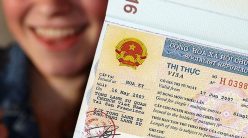Chapter 1: OVERVIEW OF TRADEMARKS AND GEOGRAPHICAL INSTRUCTIONS
- Overview of the trademark
- Concept of trademark
Agreement on Commercial Aspects of Intellectual Property Rights (TRIPs Agreement) (adopted 15 April 1994) provided for in paragraph 1, Article 15 of the definition of a mark as follows: “Any sign Any trademark or combination capable of distinguishing the registration of a trademark of goods or services of another enterprise can be used as a trademark. Such signs, in particular words, including proper names, letters, numerals, graphic elements and any combination of colors thereof, must be capable of being registered as trademarks. . In cases where the signs themselves are not capable of distinguishing the respective goods or services, Member States may provide for registrability based on the distinction achieved through use. Members may stipulate that a condition for registration of a sign must be that a sign is visible.”

Image for illustration purposes only (Internet source)
According to Vietnamese law, Clause 16, Article 4 of the Law on Intellectual Property stipulates: “A mark is a sign used to distinguish goods and services of different organizations and individuals.” This is the general definition of a trademark protected under Vietnamese law. Trademarks protected under Vietnamese law can be classified into: trademarks, collective marks and certification marks. In which, an individual or organization can register a trademark for both the goods they produce and the services they provide.
Regarding collective marks, In the intellectual property laws of most countries, there are provisions on the protection of collective marks. Collective marks are generally defined as signs that distinguish the geographical origin, materials, production patterns or other common characteristics of the goods or services of different enterprises using the same mark. group. The owner can be an association of which the businesses are members or another entity is a public organization or a cooperative. The Law on Intellectual Property of Vietnam stipulates:
A collective mark is a mark used to distinguish goods and services of members of an organization that is the owner of that trademark registration from those of organizations or individuals that are not members. member of that organization”.
The function of the collective mark is to instruct the public about certain specific characteristics of the products bearing the collective mark.
Some countries also have provisions for the protection of certification marks. Certification marks are usually issued to those who meet defined standards without any restrictions on membership. The Law on Intellectual Property of Vietnam stipulates that “Certification mark is a mark that is registered to allow other organizations or individuals to use on goods and services of that organization or individual to certify the characteristics of the goods and services of that organization or individual. origin, raw materials, materials, manner of manufacture, manner of service provision, quality, accuracy, safety or other characteristics of the goods or services bearing the mark”. . Certification marks can be used by any entity that can certify that a product meets certain established standards. Certification marks may also be used in conjunction with the private marks of the manufacturers of certain goods. Product packaging used as a certification mark is proof that your products meet specific standards set by the use of the certification mark. The basic difference between a certification mark and a collective mark is that a collective mark can only be used by specific businesses, for example, members of an association, a cooperative that owns collective marks, while certification marks can be used by anyone who strictly adheres to the defined standards set by the owner of the certification mark.
- Conditions for protection, grounds for establishing rights to trademarks
According to the provisions of Article 72 of the Intellectual Property Law, a trademark is protected if it meets the following two conditions:
“first. A sign that is visible in the form of letters, words, drawings, images, including holograms, or a combination thereof, represented by one or more colors;
- Capable of distinguishing the goods or services of the owner of the trademark registration from those of other subjects.”
Thus, Vietnamese law has not yet protected some other widely protected trademarks in the world such as sound marks and scent marks. In the current international integration situation, along with the accession to international treaties on trade, Vietnam’s intellectual property law will have a big change in trademark protection.
The establishment of industrial property rights to trademarks is done through the following forms: Establishment on the basis of applications for protection titles; Established on the basis of actual use (for well-known trademarks); Establishment through forms such as ownership transfer contract or through inheritance relationship.
- Trademark owner and registration rights
3.1 Owners of trademarks
The identification of the owner of a trademark registration can be based on the characteristics and sequence of establishing rights to the mark. In Clause 1, Article 121 of the Intellectual Property Law, it is clearly stated that the owner has ownership rights to the mark:
Trademark owner means an organization or individual that has been granted a trademark protection title by a competent authority or has an internationally registered mark recognized by a competent authority or has a well-known mark.
In case a trademark protection title is granted jointly to many organizations or individuals, industrial property rights shall be jointly owned by such organizations and individuals. The joint owners exercise their ownership rights in accordance with the civil law.
3.2 Right to register a trademark
All organizations and individuals have the right to register trademarks for the goods they produce/services they provide. In case an organization or individual puts it on the market but it is produced by another person, they still have the right to register the hcm mark for that product, provided that the producer does not use that mark for the product and does not object to the that registration.
For a collective mark, a legally established collective organization has the right to register the collective mark for use by its members in accordance with the regulations on the use of the collective mark. In case the collective mark has geographical origin (such as Ninh Thuan apple, Phan Rang garlic,…), the organization that has the right to register is a collective organization of organizations and individuals conducting production and business in Vietnam. that locality. Specifically, for the case of the Ninh Thuan apple collective mark, only organizations (business associations, cooperatives) in Ninh Thuan province have the right to register this collective mark.
For certification marks, organizations with the function of controlling and certifying quality, characteristics, origins or other criteria related to goods and services have the right to register certification marks. However, the functional organization must not conduct the production and sale of such goods or services, i.e., when becoming the owner of the certification mark registration, this organization can only grant rights to individuals , other organizations use the certification mark but cannot use that certification mark for the goods and services they produce/provide. For place names and other signs indicating the geographical origin of local specialties of Vietnam, the registration of certification marks must be permitted by a competent state agency.
Two or more organizations and individuals have the right to jointly register a mark in order to become co-owners of the mark, and have the right to jointly use and dispose of the mark when satisfying the following conditions:
“- The use of such mark must be on behalf of all co-owners or for goods and services in which all co-owners are involved in the production and business process;
– The use of such mark does not cause confusion to consumers about the origin of goods or services.”
For support and advice on intellectual property issues in the best way, please contact us with the following information:
DHP LAW
Address: L4-09.OT06 Landmark 4 Vinhomes Building Central Park, 720A Dien Bien Phu, Ward 22, Binh Thanh District, Ho Chi Minh City








